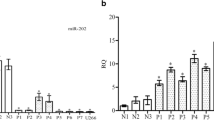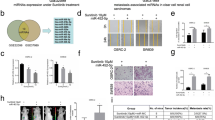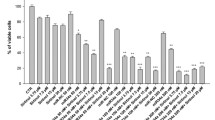Abstract
The continuous rise in relapse rate and mortality for multiple myeloma (MM) demands an effective treatment option. The microRNAs are emerging nowadays for their promising therapeutic potential. Earlier, we reported involvement of Versican (VCAN) in myeloma pathogenesis which could be inhibited by miR-144 and miR-199 in stroma. However, there is dearth of literature showcasing the direct effect of these miRs in association with VCAN in MM. Expression of miR-144 and miR-199 was determined in myeloma cell lines (RPMI8226 & U266). These miRs were inhibited by small oligos to elucidate changes in expression of VCAN along with variation in parameters such as proliferation, apoptosis, migration and invasion in vitro. Moreover, effect on certain downstream signaling cascades was also evaluated. Lastly, interaction of miRs with VCAN was assessed by reporter luciferase assay. microRNAs expression were found significantly elevated in myeloma cells in comparison to stromal levels reported previously. The antagomirs-mediated inhibition of miR-144 and miR-199 significantly induced VCAN expression in myeloma cells along with alteration in myeloma-associated parameters in favor of myeloma pathogenesis with downstream activation of FAK/STAT3 signaling. Interestingly, miR-144 found to have direct binding with VCAN 3′ UTR while miR-199 possess different mechanism. The inhibition of miR-144 and miR-199 contributed in myeloma progression via upregulation of VCAN in vitro affirming the translational significance of VCAN and associated microRNAs in MM. These miRs, hence might be employed for targeting VCAN and might emerge as an effective therapy for the better outcome of MM in clinical settings in future.




Similar content being viewed by others

References
Palumbo A, Anderson K (2011) Multiple myeloma. N Engl J Med 364(11):1046–60
Bray F, Ferlay J, Soerjomataram I, Siegel RL, Torre LA, Jemal A (2018) Global cancer statistics 2018: GLOBOCAN estimates of incidence and mortality worldwide for 36 cancers in 185 countries. CA Cancer J Clin 68(6):394–424
Ghobrial IM (2012) Myeloma as a model for the process of metastasis: implications for therapy. Blood 120(1):20–30
Khan R, Gupta N, Kumar R, Sharma M, Kumar L, Sharma A (2014) Augmented expression of urokinase plasminogen activator and extracellular matrix proteins associates with multiple myeloma progression. Clin Exp Metastasis 31(5):585–93
Gupta N, Khan R, Kumar R, Kumar L, Sharma A (2015) Versican and its associated molecules: potential diagnostic markers for multiple myeloma. Clin Chim Acta Int J Clin Chem 10(442):119–24
Gupta N, Sharma A, Sharma A (2020) Emerging biomarkers in Multiple Myeloma: a review. Clin Chim Acta Int J Clin Chem 503:45–53
Hope C, Ollar SJ, Heninger E, Hebron E, Jensen JL, Kim J et al (2014) TPL2 kinase regulates the inflammatory milieu of the myeloma niche. Blood 123(21):3305–15
Hope C, Foulcer S, Jagodinsky J, Chen SX, Jensen JL, Patel S et al (2016) Immunoregulatory roles of versican proteolysis in the myeloma microenvironment. Blood 128(5):680–5
Gupta N, Kumar R, Sharma A (2016) Versikine, a proteolysis product of Versican: novel therapeutics for multiple myeloma. Transl Cancer Res 5(7):S1437-9
Gupta N, Kumar R, Seth T, Garg B, Sharma A (2020) Targeting of stromal versican by miR-144/199 inhibits multiple myeloma by downregulating FAK/STAT3 signalling. RNA Biol 17(1):98–111
Shivdasani RA (2006) MicroRNAs: regulators of gene expression and cell differentiation. Blood 108(12):3646–53
Gupta N, Kumar R, Seth T, Garg B, Sati HC, Sharma A (2019) Clinical significance of circulatory microRNA-203 in serum as novel potential diagnostic marker for multiple myeloma. J Cancer Res Clin Oncol 145(6):1601–11
Tianhua Y, Dianqiu L, Xuanhe Z, Zhe Z, Dongmei G (2020) Long non-coding RNA Sox2 overlapping transcript (SOX2OT) promotes multiple myeloma progression via microRNA-143-3p/c-MET axis. J Cell Mol Med 24(9):5185–94
Zhao Y, Xie Z, Lin J, Liu P (2017) MiR-144-3p inhibits cell proliferation and induces apoptosis in multiple myeloma by targeting c-Met. Am J Transl Res 9(5):2437–46
Zhang H-Y, Li C-H, Wang X-C, Luo Y-Q, Cao X-D, Chen J-J (2019) MiR-199 inhibits EMT and invasion of hepatoma cells through inhibition of Snail expression. Eur Rev Med Pharmacol Sci 23(18):7884–91
Yan C, Zhang L-H, Shan F, Li S-X, Jia Y-N, Li Z-Y (2018) Effect of MicroRNA-199 on proliferation and migration of gastric carcinoma cells. Zhongguo Yi Xue Ke Xue Yuan Xue Bao 40(4):528–33
Zhang W, Qian S, Yang G, Zhu L, Zhou B, Wang J et al (2018) MicroRNA-199 suppresses cell proliferation, migration and invasion by downregulating RGS17 in hepatocellular carcinoma. Gene 15(659):22–8
Satyam A, Tsokos MG, Tresback JS, Zeugolis DI, Tsokos GC (2020) Cell-derived extracellular matrix-rich biomimetic substrate supports podocyte proliferation, differentiation, and maintenance of native phenotype. Adv Funct Mater 30(44):1908752
Fang L, Du WW, Yang X, Chen K, Ghanekar A, Levy G et al (2013) Versican 3′-untranslated region (3′-UTR) functions as a ceRNA in inducing the development of hepatocellular carcinoma by regulating miRNA activity. FASEB J Off Publ Fed Am Soc Exp Biol 27(3):907–19
Yang W, Yee AJM (2014) Versican 3′-untranslated region (3′UTR) promotes dermal wound repair and fibroblast migration by regulating miRNA activity. Biochim Biophys Acta 1843(7):1373–85
Lee DY, Jeyapalan Z, Fang L, Yang J, Zhang Y, Yee AY et al (2010) Expression of versican 3′-untranslated region modulates endogenous microRNA functions. PloS One 5(10):e13599
Wei D, Shen B, Wang W, Zhou Y, Yang X, Lu G et al (2019) MicroRNA-199a-5p functions as a tumor suppressor in oral squamous cell carcinoma via targeting the IKKβ/NF-κB signaling pathway. Int J Mol Med 43(4):1585–96
Wu Y, Chen L, Zheng P-S, Yang BB (2002) beta 1-Integrin-mediated glioma cell adhesion and free radical-induced apoptosis are regulated by binding to a C-terminal domain of PG-M/versican. J Biol Chem 277(14):12294–301
Carthy JM, Meredith AJ, Boroomand S, Abraham T, Luo Z, Knight D et al (2015) Versican V1 Overexpression Induces a Myofibroblast-Like Phenotype in Cultured Fibroblasts. PloS One 10(7):e0133056
Li X, Li Y, Jiang C, Chen L, Gan N (2020) MicroRNA-144-3p Inhibits Tumorigenesis of Oral Squamous Cell Carcinoma by downregulating ERO1L. J Cancer. 11(3):759–68
Cui X, Guo Y, Wang Q, Li X (2019) MiR-199-3p-Dnmt3a-STAT3 signalling pathway in ovalbumin-induced allergic rhinitis. Exp Physiol 104(8):1286–95
Acknowledgements
The fellowship of Ms. Nidhi Gupta was granted by the Council of Scientific and Industrial Research (CSIR), India (Grant Number: 09/006(0451)/2015-EMR-I). The funding for this work was supported by the All India Institute of Medical Sciences (AIIMS), New Delhi, India (Grant Number: A-489).
Author information
Authors and Affiliations
Contributions
NG and AS contributed to the study conception and design. NG performed all the experiments, data acquisition and analysis. RK helped in methodology and data analysis. AS provided all the necessary expertise and instrumentation facilities to carry out the work. The first draft of the manuscript was written by NG and edited by AS. All authors have read and approved the final manuscript.
Corresponding author
Ethics declarations
Conflict of interest
There is no conflict of interest among authors.
Additional information
Publisher's Note
Springer Nature remains neutral with regard to jurisdictional claims in published maps and institutional affiliations.
Supplementary Information
Below is the link to the electronic supplementary material.
Rights and permissions
About this article
Cite this article
Gupta, N., Kumar, R. & Sharma, A. Inhibition of miR-144/199 promote myeloma pathogenesis via upregulation of versican and FAK/STAT3 signaling. Mol Cell Biochem 476, 2551–2559 (2021). https://doi.org/10.1007/s11010-020-04038-5
Received:
Accepted:
Published:
Issue Date:
DOI: https://doi.org/10.1007/s11010-020-04038-5



